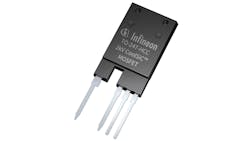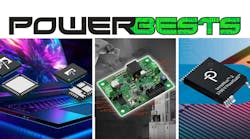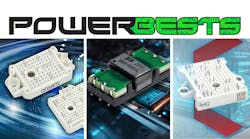What you’ll learn:
- Power devices continue to evolve rapidly as SiC and GaN technologies become more highly integrated, easy to use, and cost-effective.
- Meanwhile, steady improvements in MOSFET structures and processes enable moderately priced silicon devices to deliver performance that was only available from wide-bandgap products a few years earlier.
- The steadily growing markets for EVs, renewable power systems, and high-efficiency industrial and consumer applications is helping stimulate the demand for cost-effective application-specific power solutions.
Infineon 2,000-V SiC MOSFETs Increase Power Density without Compromising Reliability
The latest CoolSiC MOSFET 2,000-V series of SiC power transistors from Infineon Technologies will be available in the TO-247PLUS-4-HCC package to meet designers' demand for increased power density with high reliability under demanding high voltage and switching frequency conditions. The transistors are ideally suited for high DC link systems with up to 1,500 V DC. Compared to 1,700-V SiC MOSFETs, the devices also provide a sufficiently high overvoltage margin for 1,500-V DC systems.
The CoolSiC MOSFETs deliver a benchmark gate threshold voltage of 4.5 V and come equipped with a robust body diode for hard commutation. Due to the .XT connection technology, the components offer first-class thermal performance. With low switching losses, the devices are well-suited for solar (e.g., string inverters) as well as energy storage systems and electric-vehicle charging applications.
The TO-247PLUS-4-HCC package, which features a creepage distance of 14 mm and clearance distance of 5.4 mm, offers excellent moisture resistance.
Originally appeared in the March 2024 edition of PowerBites
Navitas GaN Power ICs Offer Autonomous EMI Control and Lossless Sensing
Navitas Semiconductor’s GaNSlim full-featured power ICs simplify the design of compact, efficient supplies for consumer applications by integrating drive, control, and protection. The ICs’ integrated EMI control and lossless current sensing squeezes into a high-thermal-performance proprietary DPAK-4L package. Target applications include chargers for mobile devices and laptops, TV power supplies, lighting, etc.
The devices offer low standby current (below 10 µA) and are compatible with industry-standard SOT23-6 controllers. Lossless current sensing eliminates the need for discrete resistors and optimizes system efficiency and reliability. Overtemperature protection ensures system robustness and auto sleep-mode increases light and no-load efficiency. Autonomous turn-on/off slew-rate control maximizes efficiency and power density while reducing external component count, system cost and EMI.
GaNSlim ICs are housed in a 4-pin, high-thermal-performance, low-profile, low-inductance, DPAK package that enables 7°C lower temperature operation versus conventional alternatives. They can support high-power-density designs with ratings of up to 500 W.
Originally appeared in the October 2024 edition of PowerBites
Microchip 3.3-kV Plug-and-Play SiC Gate Driver Simplifies High-Voltage Module Design
The 3.3 kV XIFM plug-and-play mSiC gate driver developed by Microchip Technology significantly reduces the time required to evaluate SiC devices and optimize their performance in inverters and other power applications. The driver features proprietary Augmented Switching technology, which supports a set of “turn-on/off” gate-drive profiles that have been tailored to optimize module performance of many of Microchip's most popular SiC power modules.
The XIFM digital gate driver features digital control, an integrated power supply, and a robust fiber-optic interface that improves noise immunity. Its preconfigured “turn-on/off” gate-drive profiles are tailored to optimize module performance.
Originally appeared in the March 2024 edition of PowerBites
ST Automotive-Grade MDmesh Superjunction MOSFETs Prove Silicon Still Matters
STMicroelectronics' automotive-grade 600/650-V superjunction MOSFETs in the STPOWER MDmesh DM9 AG series deliver high efficiency and ruggedness for onboard chargers (OBCs) and DC-DC converter applications in both hard- and soft-switching topologies. With outstanding RDS(on) per die area and minimal gate charge, the silicon-based devices combine low energy losses with outstanding switching performance, setting a new benchmark figure of merit.
The devices are fabricated using ST's latest MDmesh DM9 technology. It produces a tighter gate-source threshold voltage (VGS(th)) spread that results in sharper switching for lower turn-on and turn-off losses.
The MDmesh DM9 AG series' extremely low reverse-recovery charge (QRR) and fast recovery time (tRR) suit these devices for phase-shift zero-voltage-switching topologies that demand the utmost efficiency. The family offers a selection of through-hole and surface-mount packages that help designers achieve a compact form factor with high power density and system reliability.
The TO-247 LL (long-lead) is a through-hole option that eases design-in and leverages proven assembly processes. Among the surface-mount package options, the H2PAK-2 (2 leads) and H2PAK-7 (7 leads) are optimized for bottom-side cooling with thermal substrates or PCBs featuring thermal vias or other enhancement.
Originally appeared in the March 2024 edition of PowerBites







